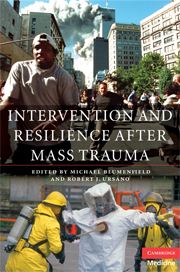Book contents
- Frontmatter
- Contents
- List of contributors
- Foreword by Joseph T. English
- Preface
- 1 Systems, science, and populations: Effective early mental health intervention following mass trauma: the roles of government, clinicians, and communities
- 2 Factors in the development of community resilience to disasters
- 3 Psychological first aid
- 4 Acute stress disorder and early interventions after trauma
- 5 The role of pharmacotherapy in early interventions
- 6 Should culture considerations influence early intervention?
- 7 Resilience is the default: how not to miss it
- 8 Epilog: Early intervention for individuals and communities: planning for the future while meeting present needs
- Index
Preface
- Frontmatter
- Contents
- List of contributors
- Foreword by Joseph T. English
- Preface
- 1 Systems, science, and populations: Effective early mental health intervention following mass trauma: the roles of government, clinicians, and communities
- 2 Factors in the development of community resilience to disasters
- 3 Psychological first aid
- 4 Acute stress disorder and early interventions after trauma
- 5 The role of pharmacotherapy in early interventions
- 6 Should culture considerations influence early intervention?
- 7 Resilience is the default: how not to miss it
- 8 Epilog: Early intervention for individuals and communities: planning for the future while meeting present needs
- Index
Summary
Traumatic events and disasters are an unexpected but not uncommon aspect of our lives. Disasters of the scale of the Southeast Asian tsunami in 2004 are thankfully rare. But consider that, worldwide, there are over 20 000 earthquakes a year and over 1300 per year are magnitude 5 or greater. The earthquake in Iran in 1990 killed 50 000 people. In the Armenian earthquake of 1988 over 25 000 died and the earthquake in Tangshan China in 1976 resulted in at least 255 000 deaths and perhaps as many as 655 000 (National Earthquake Information Center).
Earthquakes are only one of many natural disasters yet they highlight the difficulty of planning and understanding the mental health effects of traumatic events, disasters, and terrorism. Earthquake disasters remind us that the distinction between natural and human-made disasters is only relative. In an earthquake, those buildings built with poor materials or built near the water in the case of a tsunami are at much increased risk. Worldwide, those of lower socioeconomic means have a high likelihood of becoming disaster victims, because their homes are often built in high risk areas (Brewin et al., 2000).
The public health perspective on early intervention requires considering the needs of large populations as well as individuals. Disaster mental and behavioral health is directed to fostering resilience and recovery while recognizing that trauma, disaster, and terrorism lead to mental illness, distress, and health-risk behaviors all of which must be planned for and considered in early intervention (Benedek and Ursano, 2005; Fullerton et al., 2007).
- Type
- Chapter
- Information
- Intervention and Resilience after Mass Trauma , pp. xv - xviiiPublisher: Cambridge University PressPrint publication year: 2000



